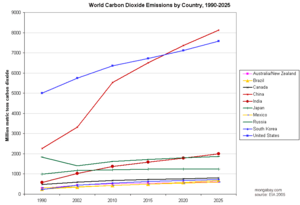From a “Green Farce” to a Green Future - Refuting False Claims About Immigrants and the Environment (21 page pdf, Center for American Progress, Oct. 2010)
Immigration is a sensitive political issue in many countries, particularly in the report reviewed today which focuses on the situation in the USA. The report challenges claims that immigrants cause or contribute to environmental degredation, especially regarding the difficulty faced by climate change policy makers in getting Americans (and Canadians, I dare say) to adopt less polluting life styles and shift energy use off carbon sources. Once again, the role of cities is seen as crucial in finding solutions – in addition to encouraging more, rather than fewer, immigrants with inherently greener outlooks. What is not discussed in the report is the environmental record of countries and the societies from where the immigrants come – which might reveal a not surprising link between lower standards of living and lower consumption, for example, which might change when the immigrant becomes part of a higher income, higher polluting society.

Key Findings:
- “The 10 highest carbon-emitting cities have an average immigrant population below 5 percent
- The cities with the lowest carbon footprint have an average immigrant population of 26 percent.
- Immigrants.. are more likely to use public transportation and practice sustainable habits like compact living, conservation, and recycling.
- Immigrants, who are largely low income, are also more likely to have their lives disrupted by extreme weather events and other adverse effects of climate change.
- Addressing climate change and poverty on a global scale will help stabilize immigration flows from undeveloped countries.
- Immigrants are disproportionately hurt by the dirty energy economy and face unique environmental challenges
- Immigrants ..accounted for 70 percent of men and women who entered the engineering and science fields”
Key Energy Facts:
- “Thirty-eight percent of U.S. GHG emissions come from buildings.
- Commercial and industrial buildings account for as much as 50 percent of U.S. energy use and residential buildings account for another 20 percent.
- Twenty-nine percent of U.S. GHG emissions come from transportation.
- Seventeen percent of global GHG emissions are caused by deforestation.
- Fifty-seven percent of global GHG emissions are caused by burning fossil fuels.
- The United States meets 85 percent of its energy needs by burning fossil fuels”
Key Recommendations:
- “mandatory annual electricity and natural gas consumption reduction targets for utilities—can save 262 million metric tons of greenhouse gas emissions.
- Expand renewable energy. ..Remarkably, only 7 percent of our current national energy portfolio comes from renewable sources
- Curb deforestation. Tropical deforestation is responsible for more emissions than all the cars, trucks, planes, and ships in the world combined.
- Limit fossil fuels..include improved fuel economy standards, development of advanced bio-fuels, incentives for nonpolluting electric vehicles, and use of natural gas.
- Plan smart cities…include widely available mass transit and walking-bicycle paths (to curb vehicle travel), compact residential and commercial development (to curb overuse of open space), and efficient use of electricity and water through networked resource management, also called a “smart grid.”
“The reality is that our environmental impact is not just determined by our numbers, but how we use resources—how we produce and consume energy, and what policies we put in place to shape these decisions“
“the world will be utterly unable to solve its significant environmental challenges so long as problems of global importance are viewed through a narrowly nationalistic lens”
Related articles
- Global Mayors Sign Climate-Change Agreement as GHG Emissions Projected to Rise in 2010 (environmentalleader.com)
- Carbon emissions dip in 2009, to jump in 2010 (reuters.com)
- Lack of Action on GHG Emissions Could Hurt US Trade (environmentalleader.com)
- Is Immigration a Green Issue? (Video) (treehugger.com)
- Fewer Jobs, More Immigrants: Despite Loss of 1 Million Jobs, 13.1 Million Arrived 2000-09 (prnewswire.com)
- Students Launch "No More Arizonas" Tour (immigration.change.org)
- Rethinking immigration (politico.com)
- The Startup Case For Immigration Reform (blogs.forbes.com)
- Startups' Case for Immigration (blogs.forbes.com)
- Immigration Creates US Jobs (rulesofwork.com)


No comments:
Post a Comment